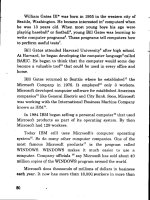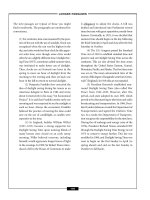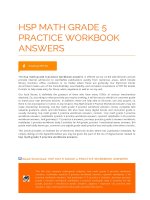Reading 5 Practice
Bạn đang xem bản rút gọn của tài liệu. Xem và tải ngay bản đầy đủ của tài liệu tại đây (3.02 MB, 77 trang )
UNIVERSITY OF ECONOMICS HO CHIMINHCITY
SCHOOL OF FOREIGN LANGUAGES FOR ECONOMICS
READING
(Module 5)
Focus
on
Learning
1
UNIT 1: FIRST IMPRESSIONS
READING 1: IT’S NOT WHAT YOU KNOW
Activity 1: Discussion
What do you understand by the expression ―It‘s not what you know, but who you
know that counts‖?Do you think networking is more important in some of these
professions than others?
Activity 2: Vocabulary
Vocabulary
Part of
Definition and Example
speech
Bump into
Aggregate
Dilemma
Manipulative
Generate
Apropos of nothing
Strategist
Networker
Referral
Accelerate
Selfless
Altruistic
2
It’s not what you know
by Mike Southon
It is often said that your personal value is not what you know, but who you know. This is
powerful motivation for recent graduates to build their personal networks. But some of us
may conclude that we already have enough friends and contacts - the challenge is making the
best use of those that we already have.
Mathematics supports this argument. If you have been in business more than 20 years, you
probably have more than 150 close contacts - people you like and respect and would
recognise if you bumped into them out of their work context. If you add to this all the people
in their close networks, this aggregates to potentially more than 20,000 agreeable and
interesting people.
It is not a problem to identify other networking prospects. We all have a drawer full of
business cards and often a large number of online connections. The dilemma is how to
successfully leverage existing contacts without appearing sleazy and manipulative.
The most important lesson to learn from the best-connected individuals is that little of their
networking activity is carried out with any specific business goal in mind. They concentrate
their effort on people they most like and who seem to like them back.
Even for the shyest individual, all that is required to leverage their network is to generate a list
of people whose company they enjoy and invite them to a private dinner. This would be
apropos of nothing in particular other than the pleasure of good company.
The tools for engineering a mutually successful outcome of such events are well explained by
one of Europe‘s leading business networking strategists, Andy Lopata. His website explains
that connecting is not enough; it is important also to determine how well your contacts
understand what you do andthen how inspired they might be to provide a referral.
Lopata provides networking training and is always amazed to discover how few companies
have an effective referral strategy. One investment bank merely had a system for asking for
two referrals at the end of every meeting, regardless of whether they had built up any trust
with the client. Lopata says the chances of receiving a referral are greatly increased if they
understand exactly what you do and the problems you solve, have a high level of trust and
understand how you help people. Your chances of receiving a referral are increased if you are
also perceived to have a wider purpose to your working life.
Lopata recommends making a detailed assessment of your best contacts, the people they
know, their willingness to refer you to them and how you might inspire them to make
3
that introduction, for free. While some people offer direct financial rewards for referrals,
seasoned net- workers mostly make introductions on the basis that everyone gains a benefit,
including the prospect of referrals in return.
While high-level networking is primarily a face-to-face activity, Lopata agrees that online
tools accelerate the process.
Expert networkers work on the basis that if you connect with your network on this mutually
beneficial basis, the financial rewards will flow. Successful networking should be selfless and
altruistic, giving referrals without remembering your simple favour, and receiving them
without forgetting their kind gift.
Activity 3
What are your views on networking? To what extent do you agree with these
statements? Compare and discuss your answers.
strongly partially disagree
agree
agree
1. Networking just means socialising
with my colleagues and friends.
2. Networking is all about finding lots of
useful business contacts.
3. Networking with business contacts is
insincere and manipulative
4. Online social networking is as useful
as face-to-face networking.
5. Networking involves getting lots of
manipulative.
help from others.
Activity 4
Read the article and compare the writer’s views on networking with your own. What
points does he make in relation to the five statements in activity 3?
Activity 5
Read the article again and find words and expressions which mean the following.
1 .met someone you know when you were not expecting to (paragraph 2):
2. develop and use fully (paragraphs 3 and 5):
3. morally doubtful (paragraph 3):
4. not related to anything previously mentioned (paragraph 5):
5. when you recommend someone to another person for work (paragraphs 6 and 7):
6. move from one place to another in large amounts (paragraph 10):
4
7. caring about other people more than about yourself (two expressions) (paragraph 10):
Activity 6
Look at these extracts from the article and indicate where the adverbs in brackets
should go. Sometimes more than one answer is possible.
1.We have enough friends and contacts. (already)
2.You have more than 150 close contacts, (probably)
3.The dilemma is how to leverage existing contacts. (successfully)
4.It is important to determine how well your contacts understand what you do.(also)
5.One investment bank had a system for asking for two referrals, (merely)
6.The chances of receiving a referral are increased if they understand what you do. (greatly,
exactly)
7.High-level networking is a face-to-face activity.(primarily)
8.If you connect with your network on this beneficial basis, the financial rewards will flow,
(mutually)
Activity 7
Which of the networking strategies mentioned in the article do you find most useful? Which
do you think you will probably never use? Why?/ Whynot?
READING 2: BUSINESSES URGED TO KEEP INTERVIEW
STANDARDS HIGH
Activity 1: Discussion
What was your first impression of the organisation that you work for or the educational
institution that you study at?
Activity 2 : Vocabulary
Vocabulary
Part of
Definition and Example
speech
Sexism
Racist
Butt in
Encounter
5
Rate
Hygiene
Turn down
Values
On the line
Read this article from the Financial Times by John Willman and do the exercises that
follow.
Businesses urged to keep interview standards high
by John Willman
A third of job applicants come away from their interview with a bad impression of the
business, having faced questions unrelated to the job, poor interview preparation, sexism
and bad personal hygiene, a survey has found. In some cases, applicants complained of
racist questions and interviewers who were drunk.
Kevin Moran, a 29-year-old ITworker who went for a job in theCity, said he had been
surprised tofind it was held in a bar. "I had toshout over the noise, and one of the
interviewers kept going to the barwhen I was still speaking, butting inrudely and talking about
things thatwere completely unrelated," MrMoran said.
The survey of more than 2,000people, by Ipsos Mori for T-Mobile,found that applicants
judged apotential employer on their impressions of the working environmentand the
people employed. Theyexpected intelligent questionsrelated to the job, and a clear careerprogression plan. However, 40 percent of those who judged their interview experience as
bad said thequestions asked were nothing to dowith the job, while a third said
theinterviewer was unprepared. Morethan 31 per cent of those finding theencounter
disappointing had neverheard from the company again.
Among the complaints aboutinterviewers' behaviour by thosewho rated their encounter a
badexperience were lateness ( 18 percent), sexism (16 per cent) and badpersonal hygiene
(7 .5 per cent).Another complaint was that theinterviewer ate during the process(5.2 per
6
cent), while 11 of the 662disappointed applicants said theinterviewer was drunk. Almost
30per cent complained they had notbeen offered any refreshments,while 10 per cent said
the buildingwas dirty. As a result, almost halfthose who had experienced a badinterview
turned down the job whenit was offered.
"Interviewees are always underpressure to create a good firstimpression, but it seems that
businesses need to feel a bit of thatpressure as well," said Mark Martin,Human Resources
Director atT-Mobile UK. "Candidates arebeginning to place a company'sculture and values
at the top of theiragenda, so businesses need to thinkabout how these are expressed in
aninterview situation - or their reputation and brand could be onthe line."
Activity 3
Read through the whole article. Matcheach of these headings (a-e) to a paragraph
(1-5).
a) Businesses should think more about the firstimpressions that they create
b) Job candidates' bad first impressions of potentialemployers
c) One candidate's bad experiences
d) Particular complaints about job interviews
e) What people expect at interviews, and what manyactually get
Activity 4
Relate what these interviewees said with thecomplaints in paragraphs 1 and 2.
a) 'The guy looked as though he hadn't shaved for aweek.'
b) 'He started slurring his words.'
c) 'She didn't really know anything about the job.'
d) 'They asked me, an experienced female executive,if I'd be willing to make tea for the
boss!'
e) 'I was talking about my previous job in IT, andsuddenly he asked me which football
team Isupport.'
f) 'It was crowded, and I couldn't hear a word hewas saying.'
g) 'They didn't let me finish my sentences when Iwas speaking.'
Activity 5
Decide whether these statements aboutparagraphs 3 and 4 are true or false.
The survey ...
a) was carried out by Gallup.
b) covered more than 2,000 people.
c) found that interviewees were only interested intheir first job in the organisation, not
7
their latercareer there.
d) found that 40 per cent of those surveyed said thatthe questions at the job interview had
nothing todo with the job.
e) found that about 33 per cent of those surveyedthought that the job interviewer had not
preparedproperly for the interview.
f) found that nearly a third of those who had had abad experience did not hear anything
again fromthe company.
Activity 6
Complete this table with words fromparagraphs 3 and 4 and related words.
Verb
Noun
Survey
…………………1
………………..2
applicant, .......... 3
employ
employment,.......... 4, .......... 5…………..
expect
……………….6
interview
…………..7,……………….8,………………..9
.........……………….. 10
encounter
Activity 7
Match the nouns in activity 6 to these definitions.
a) an informal meeting, often between two or just afew people
b) an organisation that givespeople jobs
c) someone who asks for a job
d) an occasion when someone is asked questions tosee if they are suitable for a job
e) the person who is asked the questions
f) the person who asks the questions
g) someone who works for an organisation
h) the act of asking for a job
i) the process of asking people about their opinionsand publishing the results
j) what you think will happen
Activity 8
Choose the best alternative (a, b or c) to completethese statements to reflect how the
expressionsin italic are used in paragraphs 4 and 5.
8
1. If you are disappointed, you feel unhappybecause something you ...
a) expected did not happen.
b) expected did happen.
c) did not expect happened.
2. If you turn an offer down, you ...
a) accept it.
b) think about it.
c) refuse it.
3. If you feel under pressure to do something, you feel ...
a) pleased to do it.
b) obliged to do it.
c) worried about doing it.
4. A company's values are ...
a) its profits in the previous year.
b) its physical assets.
c) the ideas, ways of behaving, etc. that it thinksare important.
5. If something is at the top of your agenda, it is the thing ...
a) that you think is most important.
b) that is the most urgent.
c) in your diary that you have to do next.
6 .A company's reputation is people's ...
a) good opinion of it.
b) opinion of it, whether good or bad.
c) bad opinion of it.
7. If something such as your reputation is on the line, it is ...
a) unchangeable.
b) at risk.
c) unpardonable.
Activity 9
Discussion
Make a list of five key pieces of advice for each of a) interviewers, and b) interviewees in
your country.
9
UNIT 2: TRAINING
READING 1
Activity 1: Discussion
―It‘s all to do with the training: you can do a lot if you‘re properly trained.‖ Elizabeth II,
British monarch
Activity 2: Useful Vocabulary
Word/Phrase
Part of
speech
Definition and Example
sledge hammer
demolish
municipal
stand
embellish
speak volumes
connect the dots
turbulent
daunting
valotile
deploy
rejig
10
refine
confer
pejorative
downturn
Activity 3
Read the anecdote below about the Chinese fridge-maker Haier and answer these
questions.
1
What lesson did the new boss want his employees to learn?
2
How would you react if a manager at your organisation did something similar?
Creative destruction
by Ben McLannahan
Call it the legend of the sledge-hammer. In 1985, the Qingdao Refrigerator Factory, a small
enterprise in China‘s Shandong province, was in trouble: sales were slipping, customer
complaints were high and rising.
The new boss, Zhang Ruimin, a 36-year-old economist dispatched from the municipal
government, decided to take a stand. Lining up 76 fridges found to be defective, he
demolished one with a sledgehammer, then ordered the shocked staff to destroy the rest.
The tale has probably been embellished in the telling, but it speaks volumes of Mr Zhang‘s
determination. A quarter of a century on, the Chairman and CEO has transformed the
biggest fridge-maker in Shandong into the biggest fridge-maker in the world. Along the
way, he has broadened the portfolio: Haier sells more domestic appliances than any
company in 19 product categories in China, and is the world‘s fourth-largest white- goods
group by sales
Activity 4: Read the article below about Haier and discuss these questions.
1
What is Haier‘s approach to executive education?
2
What are the benefits of this approach?
11
Training leaders to connect the dots
by Don Sull
Firms navigating through turbulent markets face many challenges. One of the most
daunting, however, is how to develop their executives to manage effectively the range of
diverse threats and opportunities that volatile markets generate. And how to provide this
executive education in a way that offers good value for money and time.
The Chinese appliance maker Haier has risen from a nearly bankrupt collective enterprise
25 years ago to one of the most successful companies in China. Haier‘s leaders have done
many things well, among them setting up a productive system of formal executive
education designed to produce versatile general managers that Haier can deploy against a
range of possible opportunities or threats.
When I visited Haier‘s headquarters in Qingdao a few years ago, I interviewed the faculty
that ran their training centre, as well as many executives who participated in the
company‘s programmes. Every Saturday morning, all Haier‘s senior executives based in
China (totalling more than 70) attend a weekly training session. What training, you may
ask, could possibly justify half a day of Haier‘s 70 most senior leaders every week?
Executives bring current problems or opportunities to these sessions and work in teams of six
to eight to discuss their individual challenges, explore possible solutions and discuss how
best to implement proposed changes. Faculty mixes executives from different functions,
business units and provinces to increase diversity of viewpoints and periodically rejigs the
teams to keep them fresh. During the week, executives experiment with proposed solutions
and report results back to their team-mates in later sessions, discuss what worked and did
not and explore ways to refine their actions.
This approach to executive education confers several benefits. First, it enables managers to
understand interactions between various parts of the organisation and spot opportunities
for productive collaboration. Second, ongoing exposure to the issues faced by different
parts of the business helps executives to connect the dots to understand Haier‘s situation as
a whole, rather than looking at the market through the window of their own silo. Third, this
approach builds general management skills by helping executives hone the skills to
recognise and deal with a range of challenges.
These courses are anything but ‗academic‘, in the pejorative sense of ‗divorced from practice‘.
Faculty coaches provide tools and functional training closely linked to the challenges and
opportunities at hand. They also help the executives refine their action plan, devise
practical ways to track progress and facilitate mid-course correction.
12
A downturn provides an ideal opportunity for companies to rethink how they can get the
most value for their investment in executive development.
Activity 5: Complete these summary sentences. Read the article again if necessary.
1
Haier‘s executive education involves training general managers to deal with ...
2
The writer of the article interviewed ...
3
More than 70 of Haier‘s senior managers take part...
4
Executives on the programme discuss possible solutions to problems and then ...
5
Executive teams are mixed up regularly on the course to ...
6
Two of the main outcomes are that managers can better understand ...
7
Participants become more versatile as they learn to face different challenges ...
8
The coaches think of ways to check progress; they provide correction and ...
Activity 6: Match these words or phrases in italic from the article (1-10) to the correct
definition (a-j).
1 periodically rejigs the teams
a) understanding something only from your
(lines 45-46)
own position and not that of others
2 confers several benefits (line 54)
b) record the development of something or
3 spot opportunities (lines 57-58)
someone over time
4 ongoing exposure to the issues
c) chance to experience new ideas and ways
(lines 59-60)
of looking at things
d) arranges in a different way
5 connect the dots (tines 61-62) ...
e) too theoretical
6 looking ... through the window
f ) brings/offers
of their own silo(lines 63-65)
g) notice something, especially when it is
difficult to see
7 helping executives hone the skills (line 67) h) with a negative meaning
8 in the pejorative sense(line 71)
i) improve/refine
9 divorced from practice(line 72)
j) realise that something is related to
10 track progress (line 78)
something else
Activity 7: Discuss these questions.
1. How could you adapt Haier‘s approach to training to make it work in your organisation?
What issues would you have to overcome?
2. How can colleagues learn from their team-mates rather than relying on a trainer?
13
Activity 8:
Why is the ability to emphasise important in business communication?
Find examples in the article for each of these techniques.
1
Using lists of three
2
Using superlative forms
3
Using two contrasting ideas
4
Using interesting or extreme adjectives
5
Emphasising a negative statement
READING 2
Activity 1: Discussion
How are senior civil servants recruited and trained in your country?
Activity 2: Useful vocabulary
Words/Phrase
Part of
Definition and Example
speech
bureaucracy
conjure up
red tape
overturn
ethics
pursuit
tailored
reform
fabric
align
genesis
rank-and-file
14
comprise
Read this article from the Financial Times by Michael Bleby and do the exercises that
follow.
Ivory Coast turns toHEC business school
Michael Bleby
1. The image of bureaucracy in the developing world conjures up pictures of red tape
and demotivated, uncaring officials. But Charles KoffiDiby, Economy and Finance
Minister for Ivory Coast, is working to overturn that image. "We aim to strengthen ethics,
put in place a customer-oriented administration and put the human being back into the
heart of the administrative system," he says. "We would like to have a public
administration as competitive as the private sector."
2 In pursuit of this, MrDiby has introduced a corporate training programme for the 8,400
public servants in his Ministry of Economy and Finance. The tailored course, run by HEC
School of Management, Paris, is part of a wider programme of change that MrDiby is
promoting within his department. He hopes the HEC course will enable managers to bring
about much-needed reforms.
3. Roger Dault, an affiliate professor at HEC who designed and runs the programme,
explains where the weaknesses lie. 'These people need to strengthen their managerial
competencies in different areas, like how to set up a strategy, how to implement it within
the fabric of the ministry as an organisationand how to align everybody behind this
strategy."
4 Theprogramme had its genesis in 2007, when MrDiby, who has written a book on
public-sector management in Africa, met staff from HEC. "He told us: 'I want to have
real managers … people able to run an efficient administration,"' says Professor Dault. "He
said: 'Our citizens have needs and demands. We have to understand these needs and
demands and try to answer in the best possible way. I want an administration taking care of
its citizens and taking care of companies."'
Professor Dault saysMrDibyrealised that taking care of industry and investors would be
another factor of differentiation for Ivory Coast.
5 Theprogramme consists of two courses for executive and middle managers and a shorter
version for lower-level staff. The 10-day programme for executives, run over 10 months,
15
studies strategy and implementation, leadership, people management, ethics, customer
needs and change management.
6 Participants also take part in a group project. HEC conducts 10 workshops for groups
of 20 executives at a time, meaning up to 200 are trained in a year. A similar course trains
middle managers in similar numbers, with more emphasis on operations. At the third level,
rank-and-file staff take part in one-day "mega-workshops" comprising 20 tables of 10
people. By conducting discussions on customer needs, followed by ethics, they encourage
officials to respond to the changes being introduced by their managers.
Activity 3
Choose the correct alternative (a, b or c) to replace the expressions in italic from
paragraphs 1 and 2, keeping the closest meaning.
1 The image of bureaucracy in the developing world …
a) picture b) reputation c) icon
2 ... conjures up pictures of red tape and ...
a) evokes b) invokes c) provokes
3 ... demotivated, uncaring officials.
a) unmotivated b) disabused c) disinterested
4 But Charles KoffiDiby, Economy and Finance Minister for Ivory Coast, is working to
overturn that image.
a) dismantle b) abolish c) change
5 'We aim to strengthen ethics, .. .'
a) power b) reinforce c) robust
6 In pursuit of this, MrDiby has introduced a corporate training programme ..
a) To finalise this
b) To action this
c) To achieve this
7. The tailored course, run by HEC School of Management, Paris, is part of a wider
programme
of change that MrIJiby is promoting within his department.
a) specially cut
b) specially designed
c) specially conceived
Activity 4 : Decide whether these statements about paragraph 3 are true or false.
Roger Dault ...
a) wrote the programme for Ivory Coast civil servants.
16
b) thinks that managerial skills of civil servants in Ivory Coast need to be improved.
c) thinks that strategy should be decided by business school professors.
d) believes that putting strategy into action should be part of the course.
e) thinks that strategy can be applied without involving low-ranking officials.
Activity 5
Find the five groups of people/organisationsmentioned in paragraph 4. Which groups
arereferred to by more than one expression?
Activity 6 :Match these areas mentioned in paragraph 5 (1-6) to a related idea (a-f).
1 strategy formulation
2 strategy implementation
3 leadership/people management
4 ethics
5 customer needs
6 change management
a) Asking citizens what they want
b) Behaving in a moral way
c) Inspiring civil servants to work to the best of their ability
d) Persuading people to do things in new ways
e) Sitting down to discuss goals over the next 10 or 20 years
f) Thinking about how the grand plan can be put into practice
Activity 7
In paragraph 6, find
a) a verb (used twice here) that can also be used to talk about leading musicians.
b) a prefix that means 'very big'.
c) a noun that can also refer to medical procedures.
d) an adjectival expression used to refer to the ordinary members of an organisation.
e) a noun that can also refer to a place where things are made on a small scale.
f) a verb used to talk about reacting to events.
g) a verb (used in its -ing form here) meaning 'contain'.
Activity 8: Discussion
Imagine that you are Head of Training for your organisation, or one you would like to
work for. Give the outlines of an ideal management course that you would like to run for
its managers, using professors from a top management school.
17
UNIT 3: ENERGY
READING 1: THE DANGER OF LOSING TOUCH WITH REALITY
Activity 1: Discuss these statements about energy, deciding whether each one is True
(T), False (F) or you don’t know (DK). Give reasons for your answers.
1. A carbon tax on industry could help to reduce greenhouse gas emissions.
2. Changing to a low-carbon world can be achieved quite quickly.
3. Rapid growth of the world‘s population will soon increase demand for energy.
4. Most forms of alternative energy are easier to transport, store and use than oil and gas.
5. Private companies need government support to make technological advances.
6. Oil and gas prices will increase in the future.
Activity 2: Useful Vocabulary
Word/Phrase
Part of
Definition and Example
speech
curb
impose
concrete
die-hard
wear off
feasible
stifle
finite
Activity 3: Read the article and, in pairs, compare your answers to Activity 1 with Helge
Lund’s views.
18
The danger of losing touch with reality
Ed Crooks
Politicians often underestimate the massive challenge of cutting greenhouse gas emissions by
moving away from fossil fuels, according to Helge Lund, Chief Executive of StatoilHydro,
Norway‘s national oil and gas company, who is an adviser to the United Nations SecretaryGeneral on energy.
Mr Lund is far from the stereotype of the die-hard oilman. He believes it is important to
engage with the debate over climate change, and is the only oil company representative on
the group advising the UN Secretary-General, on energy.
Norway has a good record for curbing greenhouse gas emissions from its oil industry,
having been one of the first countries to impose a carbon tax, in 1991. Statoil is a pioneer of
storing carbon dioxide underground, with projects in Norway and Algeria.
Mr Lund accepts that, in the future, his customers will use less of the oil and gas that his
company produces. Yet even he is concerned that politicians are in danger of losing touch
with reality in their push for a low- carbon world. Weaning the world off oil
and gas, he
says, will be harder than many people realise. ‗Governments are moving away from the
energy source that our entire civilisation is built on: hydrocarbons. That is not an easy task,‘
he says. ‗It is very important that the debate is based on energy realities.‘
The first of those realities is demography. By 2050, the world‘s population is set to grow to 9
billion, from about 6.8 billion today, while economic development lifts hundreds of millions
out of poverty, enabling them to buy cars and fridges and air conditioning. That creates
massive upward pressure on global energy demand which, given ‗business as usual‘ policies,
will rise by 45 per cent by 2030, according to the International Energy Agency, the rich
countries‘ watchdog.
The second is the effectiveness of hydrocarbons — oil and gas - as energy sources that can be
easily extracted, transported, stored and used. Few of today‘s alternatives offer anything like
as attractive a combination of characteristics. Mr Lund‘s conclusion: ‗You can see that
planning to move away quickly from hydrocarbons is unrealistic.‘
He does not deny the science of climate change, and says there is an ‗urgent‘ need to respond
to it. But he does want to stop responses that he thinks will be counter-productive. ‗The
debate is sometimes too simplistic, and overstates the opportunity for quickly changing to a
low-carbon economy,‘ he says. ‗If we start the discussion on an unrealistic basis, we are less
likely to make any real progress.‘ The danger he highlights is of politically driven support for
19
particular technologies, which he argues will stifle innovation.
Some people seem to believe that technology can be decided politically: it cannot,‘ he says.
‗Technology advances best when you have competitive companies working on concrete
projects.‘ That means setting a price for carbon, whether through a carbon tax or, as seems
more politically feasible, an emissions trading scheme, and letting industry respond freely to
that price to come up with profitable solutions.
‗Oil and gas are finite resources, and we should expect that over time they will become more
expensive, so we should use them more carefully,‘ Mr Lund says. ‗We are going to be telling
our customers to use less of the products that we make.‘
If Mr Lund is right about the transition being slow, however, there loo is still plenty of profit
to be made from Statoil‘s traditional business. Its gas reserves in Norway and around the
world can also play an important role as a ‗transition fuel', providing a lower-carbon
alternative to coal-fired power generation while other forms of energy are built up.
Activity 4: Find the words or phrases in the article that are similar to or mean the
following.
1. changing, especially in a way that improves a situation (paragraphs 1 and 4)
2. opposing change and refusing to accept new ideas (paragraph 2)
3. get involved in (paragraph 2)
4. controlling or limiting something in order to prevent it from having a harmful effect
(paragraph 3)
5. gradually stopping someone from doing something they do habitually (paragraph 4)
6. ready to (paragraph 5)
7. organisation responsible for making sure that companies do not do anything illegal or
harmful (paragraph 5)
8. say that something is not true (paragraph 7)
9. draws people‘s attention to something by making it easily visible (paragraph 7)
10. stop something from happening or developing (paragraph 7)
11. establishing (paragraph 8)
20
12. think of an idea, answer, etc. (paragraph 8)
Activity 5: Discuss these questions.
1. In what ways are Helge Lund and Statoil both pioneers?
2. In what way does Helge Lund think government intervention in the energy industry is
positive? In what way does he think it is negative? Do you agree?
3. In what ways can the pressure on global energy demand be curbed? Which do you favour?
4. Do you think energy companies should be in private or public hands? What are your
reasons?
Activity 6: Look at the nouns and articles in bold in the article. Why do we use the
indefinite, definite or zero article in each case?
Activity 7: Fill in the blanks with the correct prepositions.
1. Helge Lund is an adviser ……….. the UN Secretary-General ………… energy.
2. It is important to engage …………… the debate …………. climate change.
3. Mr Lund is concerned that politicians are ……………. danger …………. losing touch
………… reality in their push …….. a low-carbon world.
4. The danger he highlights is ………. politically driven support …………. particular
technologies.
5. Global energy demand will rise ……….. 45% ………. 2030.
21
READING 2: ALTERNATIVE ENERGY
Activity 1: Name as many sources of energy as you can think of.
…………………………………………………………………………………………………
…………………………………………………………………………………………………
Activity 2: Useful Vocabulary
Word/Phrase
Part of
speech
Definition and Example
replete
in vogue
dwarf
eclipse
gigantic
Activity 3: Read this article by Hal Weitzman and do the exercises that follow.
Wind of change sparks US renewables revival
Hal Weitzman
The history of the US is replete with images of extravagant fossil fuel consumption: smoke
billowing from gleaming trains; long, sleek, gas-guzzling cars; gigantic refineries endlessly
pumping out plumes of dirty air. But the reputation is somewhat misleading. For much of the
country's history, renewable energy played a far more central role than it does today.
By the early 1900s, hydroelectric power supplied more than 40 per cent of US electricity
needs, and by the 1940s, hydropower provided about 75 per cent of all the electricity
22
consumed in western and Pacific northwestern states. Fossil fuel consumption, however,
rapidly eclipsed hydro, and in recent years environmental criticisms of the damage dams can
have on aquatic ecosystems led to the decommissioning of some plants.
Nowadays, hydroelectric generation supplies only a small fraction of the US's electricity.
However, its history goes to show that the country was not always the great global polluter it
is today. And as the US moves to reduce its dependence on carbon fuels, alternative energy
sources are back in vogue.
In fact, renewable energy already plays a relatively significant role in US electricity
production. Discounting hydroelectricity, the US is the world's biggest consumer of
renewable energy for electricity - consuming twice as much as Germany and three times as
much as Japan. Renewable energy, including hydro, accounted for more than 7 per cent of the
US's total energy consumption in 2008, according to the US Department of Energy. Although
that is still dwarfed by energy from petroleum, natural gas and coal, alternative energy
sources are slowly but surely taking a bigger share of the country's energy use: in 2004,
renewable energy's share of total US energy consumption stood at 6 per cent; and renewable
energy consumption grew by 7 per cent between 2007 and 2008, despite a 2-per-cent decline
in total US energy consumption.
At 7 per cent of the total, alternative energy sources are rivalling nuclear power's 9-per-cent
contribution to the US's energy make-up. Although hydroelectricity remains by far the largest
source of renewable electricity in the US, the real star of the renewable energy scene in recent
years has been wind power. The sector has grown strongly in recent years. Wind power now
provides 1.3 per cent of US total electricity generation, up from 0.4 per cent in 2004. Last
year, the US overtook Germany as the world's biggest producer of power from wind.
Activity 4: Find adjectives in paragraphs 1 and 2 that mean the following.
a) excessive
b) using a lot of petrol
c) very large
d) not giving a true idea about something
e) able to be used again
f) relating to power produced by water
23
g) relating to nature, natural resources, etc.
h) relating to water
Activity 5: Decide whether these statements about paragraphs 1 and 2 are true or false.
In thinking about the US, …
a) people imagine that fossil fuels have always been the main source of energy.
b) renewable energy has never played a big part.
c) hydroelectricity provided nearly half of energy in about 1910.
d) hydroelectricity provided three-quarters of energy in the US in the 1940s.
e) hydroelectric plants were closed because they were no longer economical.
f) fuels like oil and coal overtook hydroelectric energy.
Activity 6: Choose the alternative (a, b or c) that can replace the expression in italic
from paragraphs 4 and 5.
1. In fact, renewable energy already plays a relatively significant role in US electricity
production.
a) main
b) principle
c) important
2. Discounting hydroelectricity, the US is the world's biggest consumer of renewable energy
for electricity - consuming twice as much as Germany and three times as much as Japan.
a) Reducing b) Apart from
c) Selling
3. Renewable energy, including hydro, accounted for more than 7 per cent of the US's total
energy consumption in 2008, according to the US Department of Energy.
a) represented b) audited
c) balanced
4. Although that is still dwarfed by energy from petroleum, natural gas and coal, alternative
energy sources are slowly but surely taking a bigger share of the country's energy use:…
a) very little in relation to
b) a lot in relation to
24









